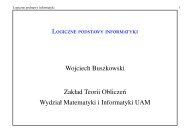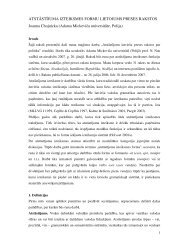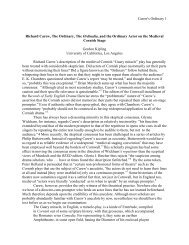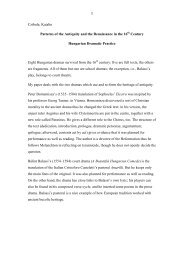Amir Weiner Getting to Know You
Amir Weiner Getting to Know You
Amir Weiner Getting to Know You
You also want an ePaper? Increase the reach of your titles
YUMPU automatically turns print PDFs into web optimized ePapers that Google loves.
44 AMIR WEINER AND AIGI RAHI-TAMM<br />
bears striking resemblance <strong>to</strong> the Soviet case but also highlights the<br />
latter’s distinctiveness. Much like the societies studied in this article,<br />
newly independent Israel gained control over a national-religious entity<br />
hostile <strong>to</strong> its very existence and then moved <strong>to</strong> integrate it as citizens<br />
while subjecting it <strong>to</strong> nearly two decades of military rule and pervasive<br />
surveillance. Informants multiplied in every sphere of public life, drawn <strong>to</strong><br />
the security services by ruthless blackmail and intimidation, the realization<br />
of Israel’s permanence and power, attraction <strong>to</strong> the state’s modern and<br />
democratic features, and rewards—such as preferential treatment in<br />
leasing land, family unification, payments, freedom of movement, the<br />
right <strong>to</strong> carry arms, the blind eye turned on smuggling activities, and<br />
career promotion. The results have been impressive, if ambiguous: the<br />
Arab minority has been thoroughly infiltrated and neutralized but only<br />
within certain limits. Inhibited by legal-democratic structures and beliefs<br />
that countered its inherent aggressiveness, as well as the state’s opting for<br />
ethno-religious over universalist national identity, the Israeli surveillance<br />
system often failed <strong>to</strong> penetrate at the family level and reap the benefits of<br />
a supranational community. In a word, it lacked the two key features that<br />
made the Soviet system so powerful. 124<br />
Indeed, the magnitude of Soviet violence often obscured its ambitious<br />
revolutionary dimensions, which, in turn, bred distinct socialist patterns of<br />
surveillance. Much like their counterparts within the pre-1939 borders, the<br />
populations of the western frontier realized early on that the Soviets sought<br />
<strong>to</strong> reach everyone and everywhere and pursued the <strong>to</strong>tal submission and<br />
transformation of anyone they laid their hands on, informants included.<br />
Surveillance was often the initial encounter with Soviet power and its<br />
bureaucratic machinery, introducing new constituencies <strong>to</strong> the rules of the<br />
Soviet game, teaching them who and what was legitimate and who and what<br />
was not. 125 The homogenizing drives, shaped by a universalist ethos and<br />
conspira<strong>to</strong>rial political culture, overwhelmed their various constituencies,<br />
conveyed the aura of inevitability and permanence, and institutionalized everexpanding<br />
social infiltration, equal-opportunity recruitment of informants,<br />
and the gathering of vast information for use in restructuring society and<br />
124 Hillel Cohen, Good Arabs: The Israeli Security Agencies and the Israeli Arabs, 1948–1967<br />
(Berkeley: University of California Press, 2010).<br />
125 See Nick Baron’s insightful observations, “Remaking Soviet Society: The Filtration of<br />
Returnees from Nazi Germany, 1944–49,” in Warlands: Population Resettlements and State<br />
Reconstruction in the Soviet–East European Borderlands, 1945–50, ed. Peter Gatrell and Nick<br />
Baron (New York: Palgrave, 2009), 89–116.

















